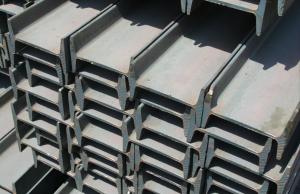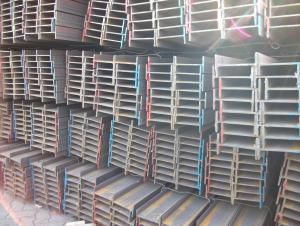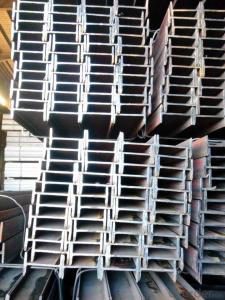I BEAM European Standard of IPE and IPEAA
- Loading Port:
- China Main Port
- Payment Terms:
- TT or LC
- Min Order Qty:
- 100 m.t.
- Supply Capability:
- 10000 m.t./month
OKorder Service Pledge
OKorder Financial Service
You Might Also Like
Product Description:
OKorder is offering I BEAM European Standard of IPE and IPEAA at great prices with worldwide shipping. Our supplier is a world-class manufacturer of steel, with our products utilized the world over. OKorder annually supplies products to African, South American and Asian markets. We provide quotations within 24 hours of receiving an inquiry and guarantee competitive prices.
Product Applications:
I BEAM European Standard of IPE and IPEAA are ideal for structural applications and are widely used in various building structures and engineering structures such as roof beams, bridges, transmission towers, hoisting machinery and transport machinery, ships, industrial furnaces, reaction tower, container frame and warehouse etc.
Product Advantages:
OKorder's I BEAM European Standard of IPE and IPEAA are durable, strong, and wide variety of sizes.
Main Product Features:
· Premium quality
· Prompt delivery & seaworthy packing (30 days after receiving deposit)
· Can be recycled and reused
· Mill test certification
· Professional Service
· Competitive pricing
Product Specifications:
Manufacture: Hot rolled
Grade: Q195 – 235
Certificates: ISO, SGS, BV, CIQ
Length: 6m-12m, as per customer request
Packaging: Export packing, nude packing, bundled
size | Kg/m |
IPE 100*55*4.1 | 8.1 |
IPEAA 100*55*3.6 | 6.72 |
IPE 120*64*4.4 | 10.4 |
IPEAA 120*64*3.8 | 8.36 |
IPE 140*73*4.7 | 12.9 |
IPEAA 140*73*3.8 | 10.05 |
IPE 160*82*5.0 | 15.8 |
IPEAA 160*82*4 | 12.31 |
IPE 200*100*5.6 | 22.4 |
IPEAA 200*100*4.5 | 17.95 |
FAQ:
Q1: Why buy Materials & Equipment from OKorder.com?
A1: All products offered byOKorder.com are carefully selected from China's most reliable manufacturing enterprises. Through its ISO certifications, OKorder.com adheres to the highest standards and a commitment to supply chain safety and customer satisfaction.
Q2: How many tons of steel products could be loaded in containers?
A2: Usually the steel products are delivered by bulk vessel because of the large quantity and the freight. However, there are no bulk vessel enter some seaports so that we have to deliver the cargo by containers. The 6m steel product can be loaded in 20FT container, but the quantity is changed according to the size, usually from 18tons to 25tons.
Q3: How soon can we receive the product after purchase?
A3: Within three days of placing an order, we will arrange production. The normal sizes with the normal grade can be produced within one month. The specific shipping date is dependent upon international and government factors, the delivery to international main port about 45-60days.
Images:


- Q: How do you calculate the load-bearing capacity of steel H-beams?
- The load-bearing capacity of steel H-beams can be calculated by determining the moment of inertia of the beam section and then using this value to calculate the maximum bending stress the beam can withstand. The moment of inertia is calculated based on the dimensions and properties of the H-beam section, including its height, width, and thickness.
- Q: Can steel H-beams be used in cold storage or refrigeration facilities?
- Steel H-beams are indeed suitable for use in cold storage or refrigeration facilities. Their strength and durability make them a popular choice in construction. In these facilities, where low temperatures are maintained, steel H-beams offer the necessary structural support. They can withstand the temperature fluctuations and extreme conditions associated with refrigeration, making them highly suitable for these environments. Moreover, steel's excellent thermal conductivity allows for efficient heat transfer, ensuring that the desired temperature levels are maintained in the cold storage or refrigeration facility.
- Q: How do steel H-beams withstand extreme weather conditions?
- Steel H-beams are constructed using high-quality steel alloys, like carbon steel or stainless steel, to ensure their ability to endure severe weather conditions. Their inherent strength and durability enable them to withstand extreme weather elements. To begin with, steel H-beams possess exceptional tensile strength, enabling them to resist heavy loads and external forces. This strength allows them to endure strong winds, heavy snow loads, and even earthquakes. Furthermore, their unique H-shape design enhances stability and structural integrity, making them less prone to bending or buckling during extreme weather. Additionally, steel H-beams often undergo coating or galvanization processes to safeguard against corrosion and rust caused by atmospheric moisture or chemicals. This protective layer acts as a barrier, preventing water and other damaging substances from penetrating the steel surface. By enhancing durability, this coating ensures the beams' ability to endure harsh weather conditions over an extended period. Moreover, due to steel's excellent heat conductivity, H-beams effectively dissipate heat generated by extreme temperatures. This property prevents excessive expansion or contraction, reducing the risk of structural damage. Consequently, steel H-beams can endure both extreme heat and cold, making them suitable for areas with significant temperature variations or severe weather. In conclusion, steel H-beams are designed to withstand extreme weather conditions due to their high tensile strength, stability, resistance to corrosion, and effective heat dissipation. These qualities make them a dependable choice for diverse construction projects, ensuring the integrity and safety of structures even in the most challenging weather environments.
- Q: Can steel H-beams be used for supporting modular building systems?
- Yes, steel H-beams can be used for supporting modular building systems. Steel H-beams are known for their high strength and load-bearing capacity, making them suitable for providing structural support to modular buildings. They can effectively distribute the weight and loads of the building system, ensuring stability and safety. Moreover, steel H-beams can be easily fabricated and customized to meet the specific requirements of the modular building system, making them a popular choice in the construction industry.
- Q: What are the common safety precautions when working with steel H-beams?
- To ensure a safe working environment while handling steel H-beams, it is important to adhere to several common safety precautions. These precautions encompass: 1. Utilizing Personal Protective Equipment (PPE): It is imperative to wear the appropriate PPE, such as a hard hat, safety glasses, gloves, and steel-toed boots, to safeguard against potential hazards. Moreover, donning high-visibility clothing is necessary to enhance visibility and prevent accidents. 2. Employing Correct Lifting Techniques: Given that steel H-beams can be heavy and unwieldy, it is crucial to employ proper lifting techniques to prevent strain or injury. This involves bending the knees, maintaining a straight back, and utilizing the legs for lifting, rather than relying on the back or arms. 3. Ensuring Secure Storage and Handling: When not in use, it is essential to store steel H-beams in a designated and secure area to avert falls or hazards. Additionally, when handling the beams, it is important to use lifting equipment, such as cranes or forklifts, to ensure safe transportation. 4. Maintaining a Safe Working Area: The work area should be free of debris, tools, or any other obstacles that may present a tripping or falling hazard. Furthermore, marking the area with caution signs or barriers is vital to prevent unauthorized personnel from entering the work zone. 5. Providing Adequate Training and Supervision: Workers should receive sufficient training on the safe handling and usage of steel H-beams. Supervisors should oversee compliance with safety protocols and offer guidance or assistance when required. 6. Conducting Regular Inspection and Maintenance: Regularly inspecting steel H-beams is essential to identify any signs of damage, such as cracks or corrosion, which could compromise their structural integrity. Damaged beams should be promptly replaced to prevent accidents. 7. Facilitating Communication and Signaling: Clear communication and signaling among workers are crucial when working with steel H-beams. This entails employing hand signals or radios to convey instructions or warnings, especially in noisy or busy construction sites. By adhering to these common safety precautions, the risk of accidents or injuries when working with steel H-beams can be significantly minimized, thereby ensuring a safer work environment for all individuals involved.
- Q: Are Steel H-Beams prone to corrosion or rust?
- Steel H-beams are not usually prone to corrosion or rust due to their composition. H-beams are typically made from carbon steel, which has a high resistance to corrosion. This is because carbon steel contains a high amount of iron and a small percentage of carbon, making it a durable material. Furthermore, H-beams are often coated with protective layers like zinc to enhance their resistance to corrosion. These coatings create a barrier that prevents moisture and oxygen from directly contacting the steel. Consequently, the likelihood of corrosion or rust developing on steel H-beams is minimal. However, it is important to note that if the protective coating becomes damaged or worn over time, the underlying steel may become susceptible to corrosion. Therefore, it is recommended to regularly inspect and maintain H-beams to ensure their long-term durability and resistance to rust.
- Q: What are the advantages of using steel H-beams?
- Using steel H-beams in construction and structural engineering projects offers several benefits. Firstly, steel H-beams are renowned for their exceptional strength and durability. Steel, being one of the most robust materials available, is perfectly suited for heavy loads and long-span structures. This makes H-beams ideal for large-scale projects like bridges, skyscrapers, and industrial buildings, where the ability to handle substantial weight and pressure is paramount. Secondly, steel H-beams provide design and construction versatility. Their unique H shape allows for easy connection and joining, enabling engineers and architects to create diverse structural configurations. This flexibility facilitates the design of complex structures and accommodates various building requirements. Moreover, steel H-beams can be readily cut and welded to fit specific project needs, making them highly adaptable and customizable. Another advantage of utilizing steel H-beams is their cost-effectiveness. Although steel may be costlier than some alternative building materials, its long-term durability and low maintenance requirements make it a cost-effective choice. Steel H-beams have a longer lifespan compared to timber or concrete beams, reducing the need for frequent repairs or replacements. Additionally, steel is resistant to pests, rot, and fire, further enhancing its longevity and reducing ongoing maintenance costs. Furthermore, steel H-beams offer excellent structural stability and rigidity. The shape and design of these beams distribute weight evenly along their length, minimizing deflection and ensuring structural integrity. This stability is crucial in preventing structural failures, particularly in projects that need to withstand high winds, earthquakes, or heavy machinery. Lastly, steel H-beams contribute to sustainable construction practices. Steel is a recyclable material, allowing for its reuse or repurposing after its initial use. This reduces the environmental impact of construction projects and promotes sustainability. Additionally, steel H-beams are typically fabricated offsite, resulting in reduced construction time and less disruption to the surrounding environment. In conclusion, the utilization of steel H-beams in construction offers advantages such as high strength and durability, design versatility, cost-effectiveness, structural stability, and contribution to sustainable construction practices. These factors make steel H-beams the preferred choice for engineers and architects when designing and constructing diverse structures.
- Q: How do steel H-beams compare to wooden beams in terms of strength?
- Steel H-beams are significantly stronger than wooden beams when comparing their strength. Steel is known for its exceptional strength and durability, making it a popular choice for structural components such as H-beams. These beams are specifically designed to provide maximum strength and support, making them ideal for large-scale construction projects and heavy-load applications. Wooden beams, on the other hand, have limitations in terms of strength compared to steel. While wood can be a suitable option for smaller, less demanding structures, it may not have the same load-bearing capacity as steel. Wood is prone to warping, splitting, and decay over time, which can compromise its overall strength and structural integrity. Steel H-beams, being made of a much stronger material, can withstand higher loads and offer better resistance to bending, twisting, and shearing forces. This enhanced strength allows them to support larger spans and heavier loads, making them a preferred choice in high-rise buildings, bridges, and industrial structures. Additionally, steel H-beams have a higher strength-to-weight ratio compared to wooden beams. This means that they can provide greater strength while using less material, resulting in lighter and more cost-effective structures. Moreover, steel is not susceptible to termite damage, rot, or other environmental factors that can degrade wooden beams over time, ensuring long-term durability. In conclusion, steel H-beams outperform wooden beams in terms of strength due to their inherent characteristics. They offer superior load-bearing capacity, increased resistance to various forces, and better durability, making them the preferred choice for heavy-duty construction projects.
- Q: What is the weight of a standard steel H-beam?
- The weight of a standard steel H-beam can vary depending on its size and dimensions. However, on average, a standard steel H-beam weighs around 33 pounds per foot.
- Q: Are steel H-beams suitable for structures with dynamic loads?
- Yes, steel H-beams are suitable for structures with dynamic loads. Steel H-beams are known for their high strength and stiffness, making them capable of handling dynamic loads such as those caused by wind, earthquakes, or moving loads. The H shape provides a balanced distribution of weight and resistance to bending, making it a popular choice for structures that require durability and stability under dynamic loading conditions.
Send your message to us
I BEAM European Standard of IPE and IPEAA
- Loading Port:
- China Main Port
- Payment Terms:
- TT or LC
- Min Order Qty:
- 100 m.t.
- Supply Capability:
- 10000 m.t./month
OKorder Service Pledge
OKorder Financial Service
Similar products
Hot products
Hot Searches
Related keywords




























